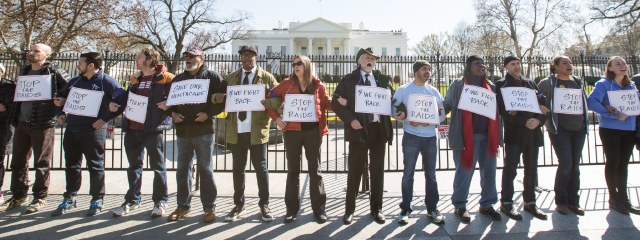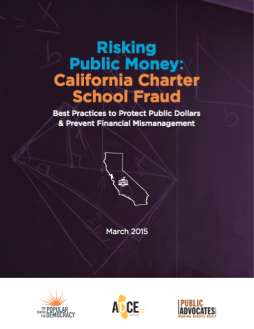Risking Public Money: California Charter School Fraud
Summary
Executive Summary
In 1992, California became the second state in the nation to pass legislation authorizing the creation of charter schools. Since the law’s passage, which originally authorized 100 charter schools, the number of charter schools in California has grown rapidly. Today, California is home to the largest number of charter schools in the country, with over 1100 schools providing instruction to over half a million students. In the 2013-14 school year, California charter schools received more than $3 billion in public funding.
Despite the tremendous investment of public dollars and the size of its charter school population, California has failed to implement a system that proactively monitors charters for fraud, waste and mismanagement. While charter schools are subject to significant reporting requirements and monitoring by oversight bodies, including chartering entities, county superintendents and the State Controller, no oversight body regularly conducts audits.
In 2006, California took a step in the right direction by amending the Charter Schools Act to permit county superintendents who suspect fraud or mismanagement at charter schools to request an “extraordinary audit” from the Financial Crisis and Management Assistance Team (FCMAT), a state agency charged with helping local educational agencies fulfill their financial and management responsibilities. Although FCMAT only conducts an audit when requested to do so, its findings reveal internal control deficiencies and various forms of mismanagement ranging in severity and form—from inappropriate self-dealing by charter school staff to the spending of thousands of public dollars without documentation. Even after 2006, charter schools in California continue to operate year in and year out without regulator-level audits that are designed specifically to determine whether the public dollars funding these privately managed schools are being spent properly. This lack of appropriate government audits is a problem, especially given the findings of FCMAT’s audits.
The number of instances of serious fraud uncovered by whistleblowers and the FCMAT suggests that the fraud problem is likely not isolated to the charter operators that have been caught. In fact, California’s charter oversight system’s deficiencies suggest that the $81,400,000 in fraud, waste and abuse by charter operators that has been uncovered to date is likely just the tip of the iceberg. Based on conservative estimates, California stands to lose more than $100 million to charter school fraud in 2015. The vast majority of this fraud perpetrated by charter officials will go undetected because California lacks the oversight necessary to identify the fraud. In this report we describe three fundamental flaws with California’s oversight of charter schools:
- Oversight depends heavily on self-reporting by charter schools or by whistleblowers. California’s oversight agencies rely almost entirely on audits paid for by charter operators and complaints from whistleblowers. Both methods are important to uncover fraud; however,neither is a systematic approach to fraud detection, nor are they effective in fraud prevention.
- General auditing techniques alone do not uncover fraud. The audits commissioned by the charter schools use general auditing techniques rather than techniques specifically designedto detect and uncover fraud. The current processes may expose inaccuracies or inefficiencies; however, without audits targeted at uncovering financial fraud, state and local agencies willrarely be able to detect fraud without a whistleblower.
- Oversight bodies lack adequate staffing to detect and eliminate fraud. In California, the vast majority of charter schools are authorized by local school districts that lack adequate staffing to monitor charter schools and ferret out fraud. Staff members who are responsible for oversight often juggle competing obligations that make it difficult to focus on oversight and identify signs of potential fraud and abuse.
To address these serious deficiencies in California’s system, we recommend the following reforms:
Mandate Audits Designed to Detect and Prevent Fraud
- Charter schools should be required to institute an internal fraud risk management program, including an annual fraud risk assessment.
- Charter schools should be required to commission an annual audit of internal controls over financial reporting that is integrated with the audit of financial statements charter schools currently commission. These integrated audits should require auditors to provide an opinion on the quality of internal controls and financial statements.
- Oversight agencies, such as the State Comptroller’s Office and Fiscal Crisis and Management Assistance Team (FCMAT), a state agency, should conduct audits on charter schools once every three years.
- Auditing teams should include members certified in Financial Forensics trained to detect fraud.
Increase Transparency & Accountability
- Oversight agencies should create a system to categorize and rank charter audits by level of fraud risk they pose to facilitate public engagement.
- Oversight agencies should post the findings of their annual internal assessments of fraud risk on their websites.
- Oversight agencies should determine what steps charter school nonprofit governing boards and executives have taken to guard against fraud over the past 10 years and issue a report to the public detailing theirs findings and recommendations.
- Charter school authorizers should take fraud risk assessments into account when evaluating whether to renew a school’s charter.
- Until the state implements the oversight mechanisms described above, authorizers should only approve new charters that commit to the fraud controls recommended above.
Given the rapid and continuing expansion of the charter school industry and the tremendous investment of public dollars, California must act now to reform its oversight system. Without reform, California stands to lose millions of dollars as a result of charter school fraud, waste, and mismanagement.













